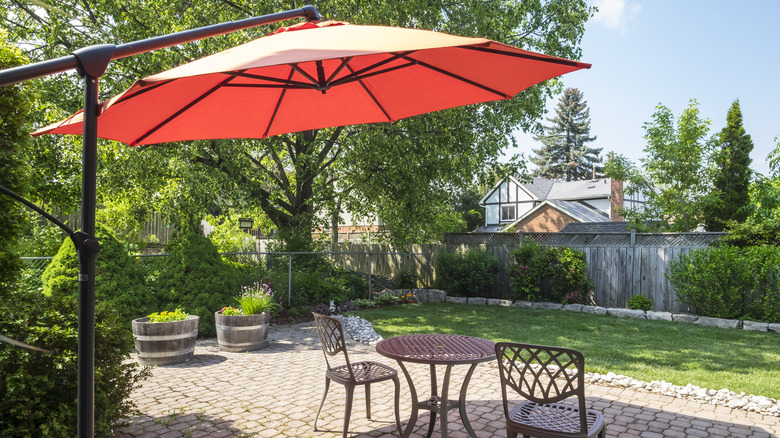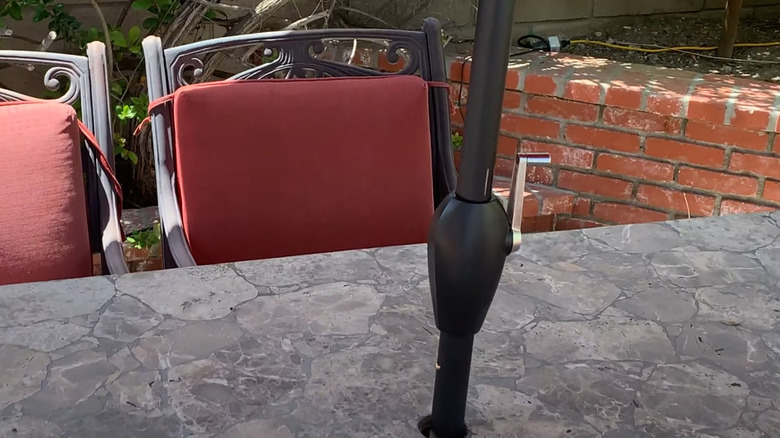Important Features To Consider When Choosing A Patio Umbrella
We may receive a commission on purchases made from links.
Those moments you're dying for a serene afternoon escape in your backyard, eager for a peaceful repose. Yet the thought of unrelenting sun rays beating down upon you casts a shadow over your daydream. Enter the hero of today's story: the patio umbrella. Choosing the right patio umbrella is more than a mere acquisition of an outdoor accessory. Through the lens of size, material, style, shape, and tilting and lifting mechanism, a seemingly straightforward decision unfolds into a journey of understanding the balance between utility and aesthetics and resilience against the whims of weather.
Let's begin with picking the right patio umbrella size. Imagine the comical scenario where an undersized umbrella offers nothing more than a symbolic relief (or on the flip side, an unreasonably colossal umbrella). The sweet spot lies in one that extends its protective shade 3 feet beyond your designated sitting area. If unsure, a patio umbrella size chart can help.
Patio umbrella shapes reveal another layer of customization. The octagonal umbrellas are the classic versions that blend seamlessly into virtually any space, while rectangular options shine in their ability to cover large rectangular dining tables. Oval umbrellas, on the other hand, combine the broad coverage of rectangular canopies with the soft edges of round designs, ideal for stretched-out dining or seating areas. Round patio umbrellas go well with round and square tables. And did you know square umbrellas, those champions for square dining arrangements, offer 30% more shade than their octagonal counterparts?
Choosing patio umbrella material and style
The patio umbrella canopy material must be resilient, built to withstand the relentless UV rays that seek to fade it and the surprise assaults of rain. Among the champions in this arena stands Sunbrella, a fabric lauded not just for its robust defense against wearing but for maintaining its vibrant hue through many seasons. The contenders don't end there, with thatch, olefin, acyclic, and polyester joining the ranks. An important part of taking care of the patio umbrella is regular cleanups of the fabric.
As crucial as the canopy is the umbrella's pole material. Aluminum, with its sleek, modern whisper and immunity to rust, offers both lightness for ease of mobility and a contemporary edge to your patio's landscape. Conversely, wood frames promise evergreen elegance, albeit with a bit of maintenance in the form of sealing. Steel poles, meanwhile, enter the mix with durability and a weightier presence, yet they demand consistent vigilance against rust. If ready to spend more on something lightweight and flexible against gusts yet durable and steadfast, fiberglass poles are on standby.
Navigating the spectrum of patio umbrella styles, you'll find the market umbrella. This exemplar, rising majestically through the table's center, merges old-world charm and functionality. Then, there's the cantilever umbrella, which makes its presence known with a blend of flexibility and innovation. Its off-center base and articulating ribs allow it to cover expansive areas like poolside lounges and sectional seating, all without the hindrance of a central pole.
The tilting and lifting mechanisms of a patio umbrella
Diving further into other best features of a patio umbrella, your choice of lifting mechanisms can define not just ease but also elegance. Beginning with the manual push-up method; this demands a bit of elbow grease but rewards you with dependability. The crank system, on the other hand, allows you to unfurl the canopy with the mere rotation of a handle. For a touch of old-world charm, the pulley system stands out, requiring a gentle tug on a cord.
Tilting comes in three options: collar, crank, and push-button. For the collar tilt, a simple twist, and voila, you can reposition the canopy to chase the shade or bask in the sunlight gracefully. Shifting the focus to the crank tilting — here, a few turns and your umbrella complies. Meanwhile, with a push-button option, a quick press frees up the canopy to move as you wish.
Far from being just an afterthought, a sturdy base guards your patio umbrella against the whims of the wind. To take the guesswork out of the minimum weight for your base, simply multiply your umbrella's canopy's width by 10. A 6.8-foot canopy, for instance, calls for a base weighing no less than 68 pounds. Portable stands like the Best Choice Products Fillable Mobile Umbrella Base, selling for $64.99 at Target, are a fresh breath of air. And in a twist that marries functionality with sustainability, how about repurposing an old bucket into a patio umbrella stand?


